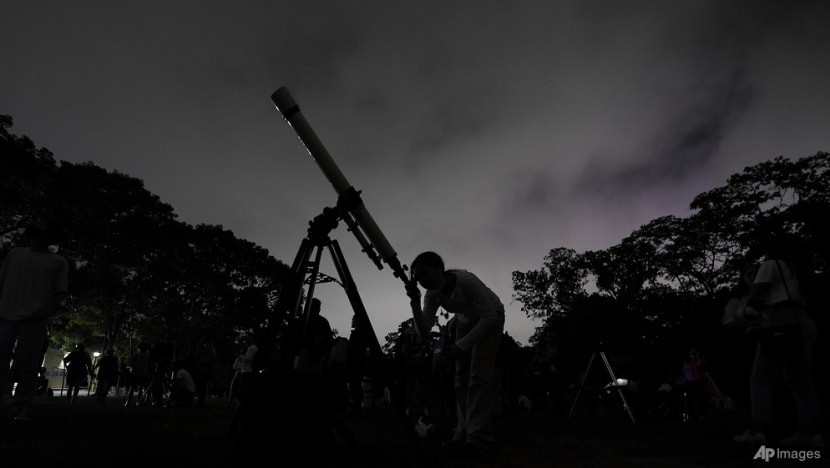Planets on parade: 5 will be lined up in the night sky this week
Jupiter, Mars, Mercury, Uranus and Venus will line up near the moon.

A girl looks at the moon through a telescope in Caracas, Venezuela, on May 15, 2022. (File photo: AP/Matias Delacroix)
NEW YORK: Keep an eye to the sky this week for a chance to see a planetary hangout.
Five planets - Jupiter, Mars, Mercury, Uranus and Venus - will line up near the moon.
WHERE AND WHEN CAN YOU SEE THEM?
According to Vito Technology, the developer behind the astronomy app Star Walk, Tuesday (Mar 28) will be the best day to catch the whole group.
You will want to look to the western horizon right after sunset, said NASA astronomer Bill Cooke.
The planets will stretch from the horizon line to around halfway up the night sky.
The five-planet spread can be seen from anywhere on Earth, as long as you have clear skies and a view of the west.
"That’s the beauty of these planetary alignments. It doesn't take much," Cooke said.
In Singapore, it will be visible for a very limited period of time after sunset.
Skygazers may be able to catch a glimpse of Jupiter and Mercury as they make a brief appearance before setting into the horizon, said science educator Tan Jyh Harng from the Science Centre Observatory.
Other local astronomy enthusiasts said Mercury and Jupiter may be too low on the horizon to be spotted.
"Beyond the two planets, Venus can be spotted as a shining star and further up, the moon can be seen approaching its first quarter, with Mars appearing as a red-orange dot right next to it, Mr Tan said.
"Uranus is also set to make an appearance, though it will not be visible to the naked eye. If planet-gazers have a telescope on hand, they can use it to locate Uranus right above Venus."
According to Mr Tan, the best chance of sightings is at locations with a clear view of the western horizon, such as along the beaches of West Coast Park.
"Venues that are elevated, such as the rooftop garden of SkyVille @ Dawson, will also make for good viewing spots," he added.
DO I NEED BINOCULARS?
Maybe. Jupiter, Venus and Mars will all be pretty easy to see since they shine brightly, NASA astronomer Cooke said. Venus will be one of the brightest things in the sky, and Mars will be hanging out near the moon with a reddish glow.
Mercury and Uranus could be trickier to spot, since they will be dimmer. You will probably need to grab a pair of binoculars.
If you are a "planet collector", it is a rare chance to spot Uranus, which is not usually visible, Cooke said. Look out for its green glow just above Venus.
DOES THIS HAPPEN OFTEN?
Different numbers and groups of planets line up in the sky from time to time. There was a five-planet line-up last June and there will be another one this June, with a slightly different make-up.
This kind of alignment happens when the planets' orbits line them up on one side of the sun from Earth's perspective, Cooke said.














